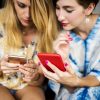Amazon Go – you enter the store, you scan your phone, you buy and then you leave. Without a queue or a cashier. Simple as that.
Nowadays, we are living so much in the middle of technological advancements, that we could easily forget how much it can revolutionize our daily lives. Are you able to remember how did you find your way before GPS, how did you look for a phone number before the internet, or how did you you pay your bills before e-banking? Our life before seemed so complicated today.
In the end, there is one sector that is quite resistant to these new techonologies, it’s the retail food trade. But it could change because Amazon, the giant e-commerce site, launched a product that begins to win more and more terrain. The product’s name is, if you didn’t hear it by now: Amazon Go.
Let’s clarify several things before going further: we are not going to cry wolf by insurgency in the face of threats to employment or the loss of privacy and evil mega corporations that will rule the world. Amazon Go is currently represented by a single physical store of a rather modest size since it extends over 170 square meters. This is more of the supermarket than the supermarket. In addition, the shop is in test version for now since only Amazon employees have access. We suspect that managing a few hundred people has nothing to do with managing thousands every day. Amazon claims to have no plans to open stores by the thousands. Auchan has nothing to fear for now.
Amazon Go will answer the special need of the person who has forgotten some things while shopping and who will make extra purchases. One could also think of the employee who has to look for a snack at noon.
The principle is simple: you identify yourself on the screen by scanning the QR code generated by the Amazon Go application installed on your smartphone. You do your shopping. The shop is loaded with sensors and artificial intelligence, the system is able to know who took what item on the shelves. Once your shopping is over, you go out without going through the cashier. A few minutes later, you receive a notification on your phone to tell you how much your cart is. The amount will be debited from your credit card.
How does it actually work?
No specific details have been yet released by Amazon, but we managed to find a file patent that gives us some clues into how Amazon Go works. It’s a combination of RFID tags, camera tracking and sensors attached on the shelves in the store. All these are combined into a system which can “view” the customer and his or hers basket.
RFID
It’s a technology that has been available for a very long time, but the implementation has been somewhat problematic. Why? Because the cost of low value convenience goods are lower than the average cost of an RFID tag. Until now, other retailers used RFID for high valued merchandise, where the cost of the tag is so much lower.
Staff
While removing checkouts, systems like Amazon Go enable cost savings. This is not a real problem, however, because staff will still be needed to resupply the shelves, answer customer questions and check the returns. Still, when you’re removing the checkout employees, you will save on operating costs, and you are offered a different customer service experience, but does everybody want that or is it too soon?
Anti-Theft
Cameras are tracking customers’ every move and RFID is tracking every product, so Amazon Go is kind of “theft proof”. Also, no cash is kept in the store, because the purchases are linked to the customer’s Amazon account. Plus, the advantages of RFID tracking apply even in the warehousing and transportation procedures, where the technology is enabling more rapid problem identification and resolution.
Customer insight
Who doesn’t love recommendations and offers? These are enabled, for example, when a customer spends a period of time deciding to buy a product, and he or she is being prompted with a pop-up that offers some cheaper or better alternatives for that product category.
Conclusion
Beyond technical performance, it’s interesting to see what applications new technologies can have on our daily lives for something as basic as buying food. Having the technological fiber, I admit that I am very excited by these demonstrations. Yes, that poses many questions for our future but we will have plenty of time to think about it later. Today, let’s just enjoy our geek fun with eyes full of stars.




